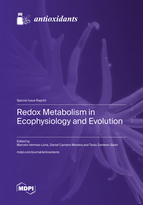Redox Metabolism in Ecophysiology and Evolution
A special issue of Antioxidants (ISSN 2076-3921).
Deadline for manuscript submissions: closed (30 April 2023) | Viewed by 22765
Special Issue Editors
Interests: animal ecophysiology; antioxidant; biochemical adaptation; comparative physiology; estivation; free radical; glutathione; hibernation; preparation for oxidative stress; reactive oxygen species; redox biology
Special Issues, Collections and Topics in MDPI journals
Interests: animal ecophysiology; antioxidant; biochemical adaptation; comparative physiology; diapause; estivation; free radical; glutathione; oxidative stress; reactive oxygen species; redox biology
Special Issues, Collections and Topics in MDPI journals
Special Issue Information
Dear Colleagues,
The accumulation of oxygen in the Earth’s atmosphere drove the evolution of an intricate system of endogenous antioxidants in aerobic organisms to deal with oxygen and its reactive products. More than a simple attack (reactive species) and defense (enzymatic and non-enzymatic antioxidants) duel, redox metabolism also comprises non-radical redox metabolites, redox-sensitive transcription factors, and redox-sensitive proteins that form a network of signaling pathways. These pathways are now known to mediate important processes in aerobic organisms, from circadian rhythms to ageing and lifespan regulation. Indeed, oxidative stress is considered a key influence on the life history of living organisms. Not surprisingly, environmental stresses might disrupt redox balance, triggering compensatory adaptive responses. The modulation of redox metabolism has been documented for phylogenetically diverse species exposed to a myriad of environmental stressors, such as warming, freezing, dehydration, exposure to UV radiation, exposure to pollutants, and variations in oxygen availability. Under natural settings, several of these environmental factors (e.g., temperature, water availability, oxygen availability, and radiation incidence) fluctuate within variable time frames (e.g., daily and seasonally). Understanding the adaptive responses of antioxidant systems to environmental perturbation is essential for elucidating the role of oxidative stress in the ecology and adaptiveness of a given taxon.
This Special Issue focuses on the responses of the redox metabolism in organisms exposed to changes in single or combined, biotic or abiotic, environmental factors (e.g., oxygen availability, temperature, drought, radiation, and pollutants). Submissions addressing evolutionary and ecological implications of redox metabolism responses are especially welcome.
Dr. Marcelo Hermes-Lima
Dr. Daniel Carneiro Moreira
Dr. Tania Zenteno-Savín
Guest Editors
Manuscript Submission Information
Manuscripts should be submitted online at www.mdpi.com by registering and logging in to this website. Once you are registered, click here to go to the submission form. Manuscripts can be submitted until the deadline. All submissions that pass pre-check are peer-reviewed. Accepted papers will be published continuously in the journal (as soon as accepted) and will be listed together on the special issue website. Research articles, review articles as well as short communications are invited. For planned papers, a title and short abstract (about 100 words) can be sent to the Editorial Office for announcement on this website.
Submitted manuscripts should not have been published previously, nor be under consideration for publication elsewhere (except conference proceedings papers). All manuscripts are thoroughly refereed through a single-blind peer-review process. A guide for authors and other relevant information for submission of manuscripts is available on the Instructions for Authors page. Antioxidants is an international peer-reviewed open access monthly journal published by MDPI.
Please visit the Instructions for Authors page before submitting a manuscript. The Article Processing Charge (APC) for publication in this open access journal is 2900 CHF (Swiss Francs). Submitted papers should be well formatted and use good English. Authors may use MDPI's English editing service prior to publication or during author revisions.
Keywords
- oxidative stress ecology
- reactive oxygen and nitrogen species
- hormesis
- redox biology
- environmental stress









